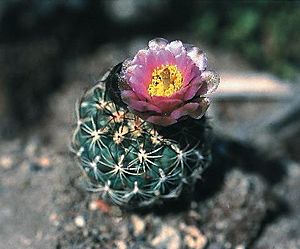Uinta Basin hookless cactus facts for kids
Quick facts for kids Uinta Basin hookless cactus |
|
|---|---|
 |
|
| Conservation status | |
| Scientific classification | |
| Kingdom: | |
| (unranked): | |
| (unranked): | |
| (unranked): | |
| Order: | |
| Family: | |
| Subfamily: | |
| Tribe: |
Cacteae
|
| Genus: | |
| Species: |
S. wetlandicus
|
| Binomial name | |
| Sclerocactus wetlandicus Hochstätter
|
|
Sclerocactus wetlandicus is a very special and rare type of cactus. It is also known as the Uinta Basin hookless cactus. This unique plant only grows in Utah in the United States, specifically in an area called the Uinta Basin.
This cactus is considered a threatened species by the United States government. This means it needs protection to survive. For a while, it was thought to be the same as another cactus, Sclerocactus glaucus. But in 1989, scientists realized it was its own special species.
Contents
What Does This Cactus Look Like?
This cactus has a round or cylinder shape. It can be green or bluish and feels a bit waxy. It grows up to 15 centimeters (about 6 inches) tall and 12 centimeters (about 5 inches) wide.
Each part of the cactus where spines grow, called an areole, has several white, tan, or black spines that spread out. It also has a few brown, black, or reddish spines in the center. The spreading spines can be up to 2 centimeters long, and the central ones can be a little longer.
When it blooms, this cactus has beautiful, funnel-shaped flowers. They can be up to 5 centimeters (about 2 inches) long and wide. The flowers are usually pink, and the outer parts might have a brownish tint. They also smell nice!
Where Does the Uinta Basin Hookless Cactus Live?
This cactus likes to grow on the sides of flat-topped hills called mesas. It prefers rough, rocky soils that have lots of small stones and gravel.
The desert areas where it lives are home to other plants too. These include plants like Atriplex confertifolia, Pleuraphis jamesii, Artemisia nova, and Achnatherum hymenoides.
The cactus flowers are pollinated by insects. This means insects help the plant make seeds. Bees, ants, and beetles are probably some of the insects that help this cactus.
You can find this cactus all over the Uinta Basin in Utah. It mainly grows in Uintah County, especially near the Green River and its smaller streams. Even though it only lives in one region, it can be found in many spots there. Scientists think there might be as many as 30,000 of these cacti!
Why Is This Cactus Threatened?
The Uinta Basin hookless cactus faces several dangers that threaten its survival:
- Damage to its home: The area where it lives is used for finding oil and gas. This can harm the cactus's habitat.
- Illegal collecting: Some people illegally take these cacti from their natural homes, which is called poaching. This reduces the number of plants in the wild.
- Off-road vehicles: Vehicles driven off roads can crush the plants or damage their habitat.
- Grazing animals: Animals eating plants can also harm the cacti or change their environment.
There are many oil wells in the area where the cactus lives. Activities related to these wells, like building and fixing roads or putting in pipelines, can break up the cactus's habitat. This can make it harder for the plants to thrive. Other problems include soil washing away (erosion), dust, and new types of weeds being brought into the area.
See also
 In Spanish: Sclerocactus wetlandicus para niños
In Spanish: Sclerocactus wetlandicus para niños


